HighRoad Spark Revolutionizes Data Integration for Associations
2020 has been like the tornado in The Wizard of Oz, ripping us all up from our familiar lives and depositing us in a strange new world.
Your members are depending on you now more than ever. They need you to offer support, networking opportunities, and programming tailored to their evolving needs. They also need to know that you’re out there, providing a strong voice for the industry and striving for a prosperous future.
But it’s also a tough time for associations. Membership growth was already a challenge even before COVID-19. How do you get young professionals to invest in their careers when the future seems so hazy?
The answer—by examining the data. Your data will tell you everything you need to know about the needs, wants, fears and desires of your current members, as well as potential future members. But first, you need to consolidate your data.
Why do associations need data integration?
You have access to a vast wealth of member information. You have data about how your members engage with programming, data about how visitors use your website, and data about membership renewal and attrition.
Unfortunately, this information is spread across multiple systems. Your AMS, your CMS, your marketing automation platform, and your email automation platform, just to name a few, all hold critical data.
Think of your tech stack like a big (pre-COVID) dinner party where none of the guests know each other. You can talk to them one-to-one, but the party doesn’t really start until they’re all talking to each other.
This is essentially the nature of data integration. It’s simply a matter of getting all your data-rich systems talking to each other. If you want that to happen quickly and efficiently, you’ll need a data integration platform.
What is a data integration platform?
Most applications can communicate with an Application Programming Interface (API). Think of an API as a kind of phrasebook that translates questions into a language that the software understands, and vice versa.
Integration means moving data from one system to another. For example, you might want to export contact details from your AMS and import them into your email automation platform. This means working with two APIs: the AMS interface and the email platform’s interface.
This is where a data integration platform comes in. These software platforms are pre-configured to work with a library of APIs, so you don’t need to do any additional coding. Simply select the source application and the destination application, and the platform will connect to both automatically. You can then run complex queries to move data from A to B.
Associations do have one problem, however: most commercial data integration platforms don’t support Association Management Software (AMS). As the AMS is the heart of your tech stack, this renders most commercial solutions useless.
Spark – The data integration platform for associations
Spark is a data integration platform designed specifically for association usage. It pairs with most AMS platforms, as well as marketing automation, email automation platforms, and other essential association tools (i.e. LMS, EMS, etc.)
Spark is a no-code solution to data integration that anyone can use, even if they have limited technical know-how. All integrations are performed through a simple visual interface that takes you through the following steps:
Authorize your applications
The first time you use Spark with any of your applications, you’ll need to grant API access for that particular app. Usually, you’ll have to provide an API key, which is a long string of numbers and letters. You obtain this key from the application or the vendor’s website.
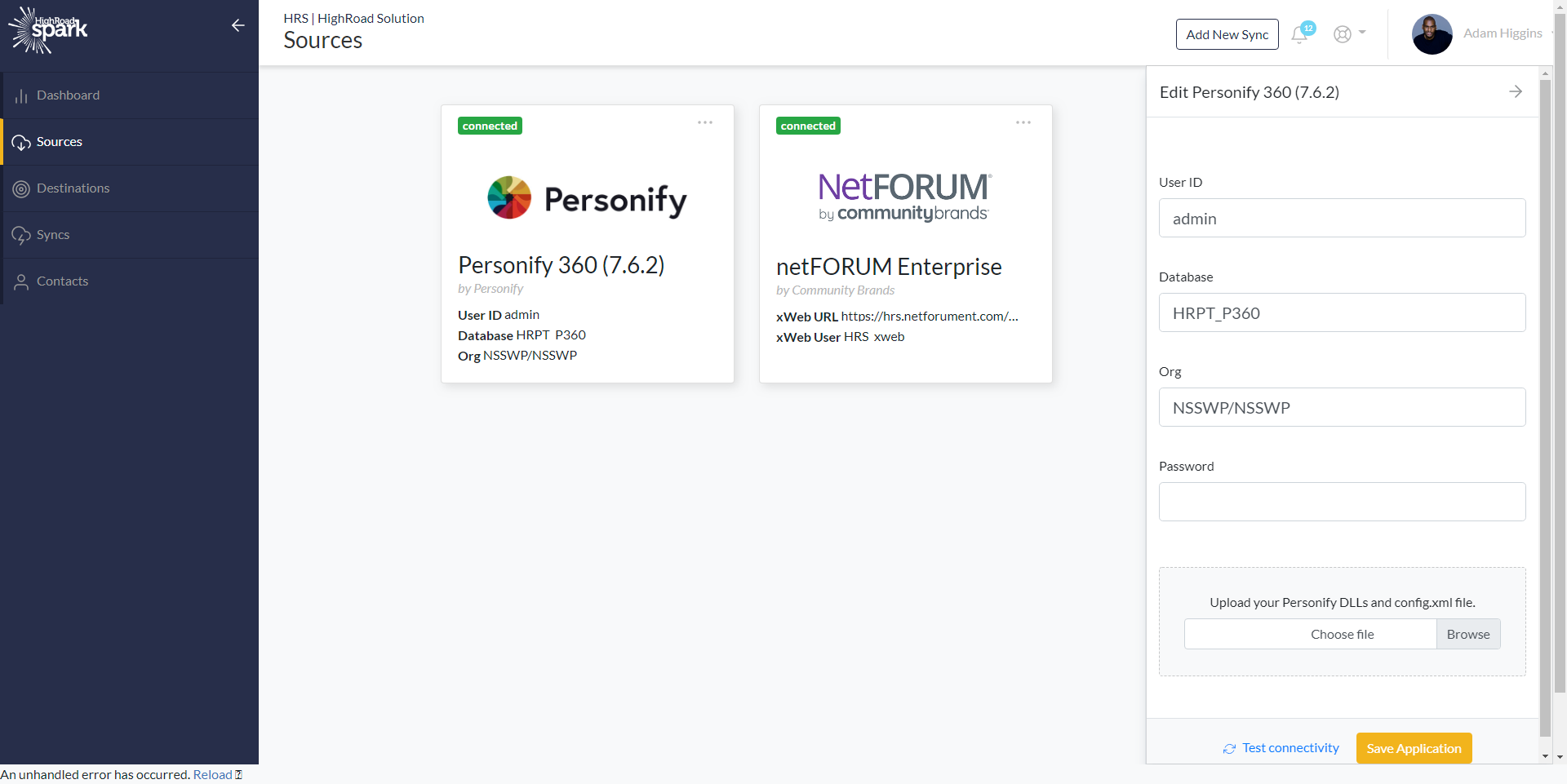
Authentication via API is completely secure. Spark talks to the API, and then the API talks to the underlying system. At no point is your data exposed or vulnerable.
Using a data integration platform like Spark can actually improve overall security. Without a data integration platform, you would need to create multiple integrations. So, for example, your AMS might be connected to a dozen other platforms. This creates a tangled web of integrations that can make your network vulnerable.
With a data integration platform, each application only has one connection: to Spark. So, for example, your AMS talks directly to Spark. Spark can use the API to securely import data from the AMS, and then use a separate API call to pass that data to a different system, like your marketing automation platform.
Authentication only needs to be performed once per application. Once you’re set up, you can sync data whenever you like.
Create a new sync
Once you’ve connected multiple systems, you need to tell the data integration platform how to sync them. Sometimes, you’ll want to copy all data from System A to System B. Other times, you may only want to sync certain parts of the data, or you may need to remove obsolete data from one of your applications.
Spark’s menu offers four ways to sync information:
- All customer: Sync all contacts within the source database
- Segmentation: Sync a specific segment of contacts
- Invalid: Remove invalid data from the source, such as spam traps
- Opt-out sync: Update marketing preferences for members
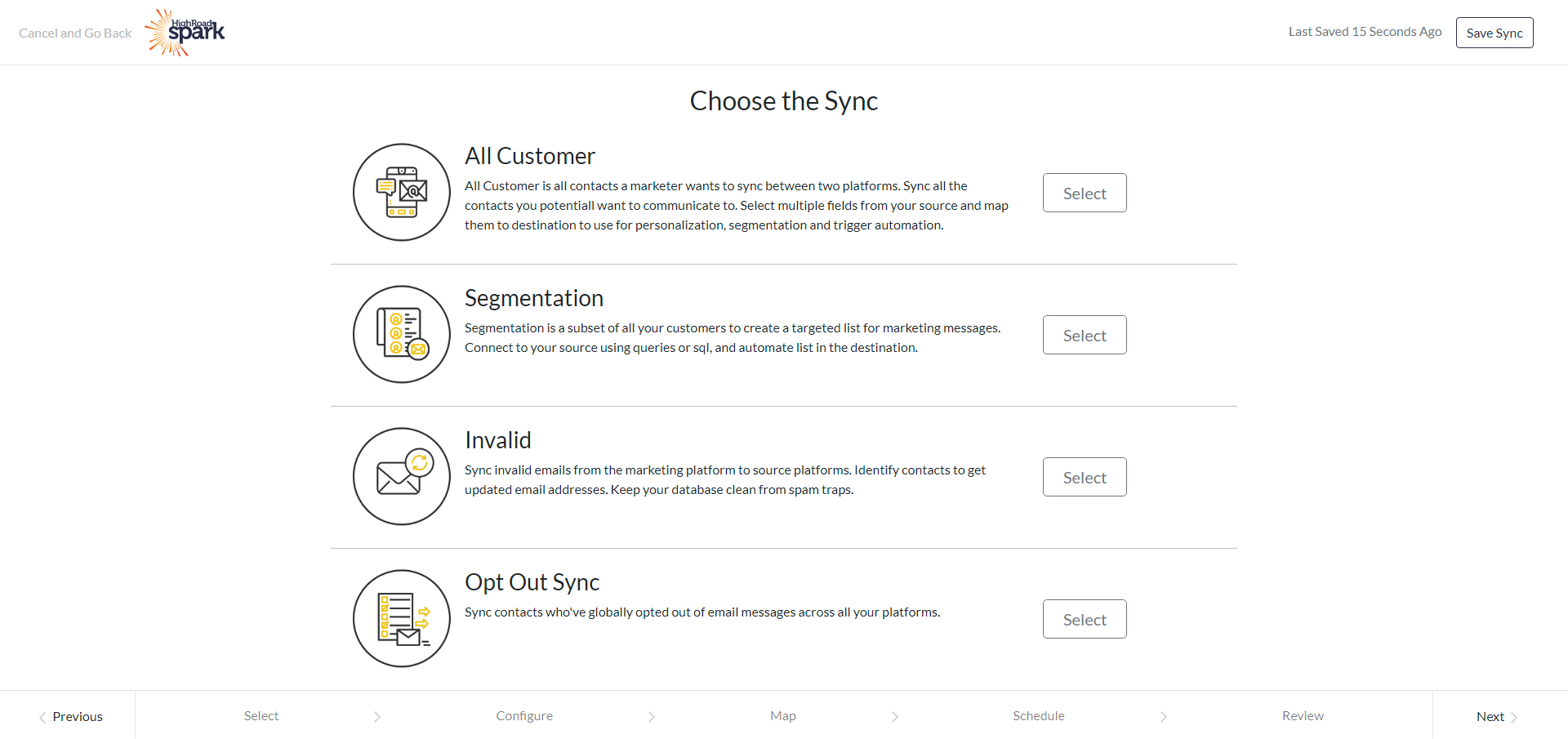
Note that these options are tailored for marketers working within associations. Other commercial data integration platforms may offer alternative options with less relevance.
- Source: Where you’re getting data from
- Destination: Where you’re writing data to
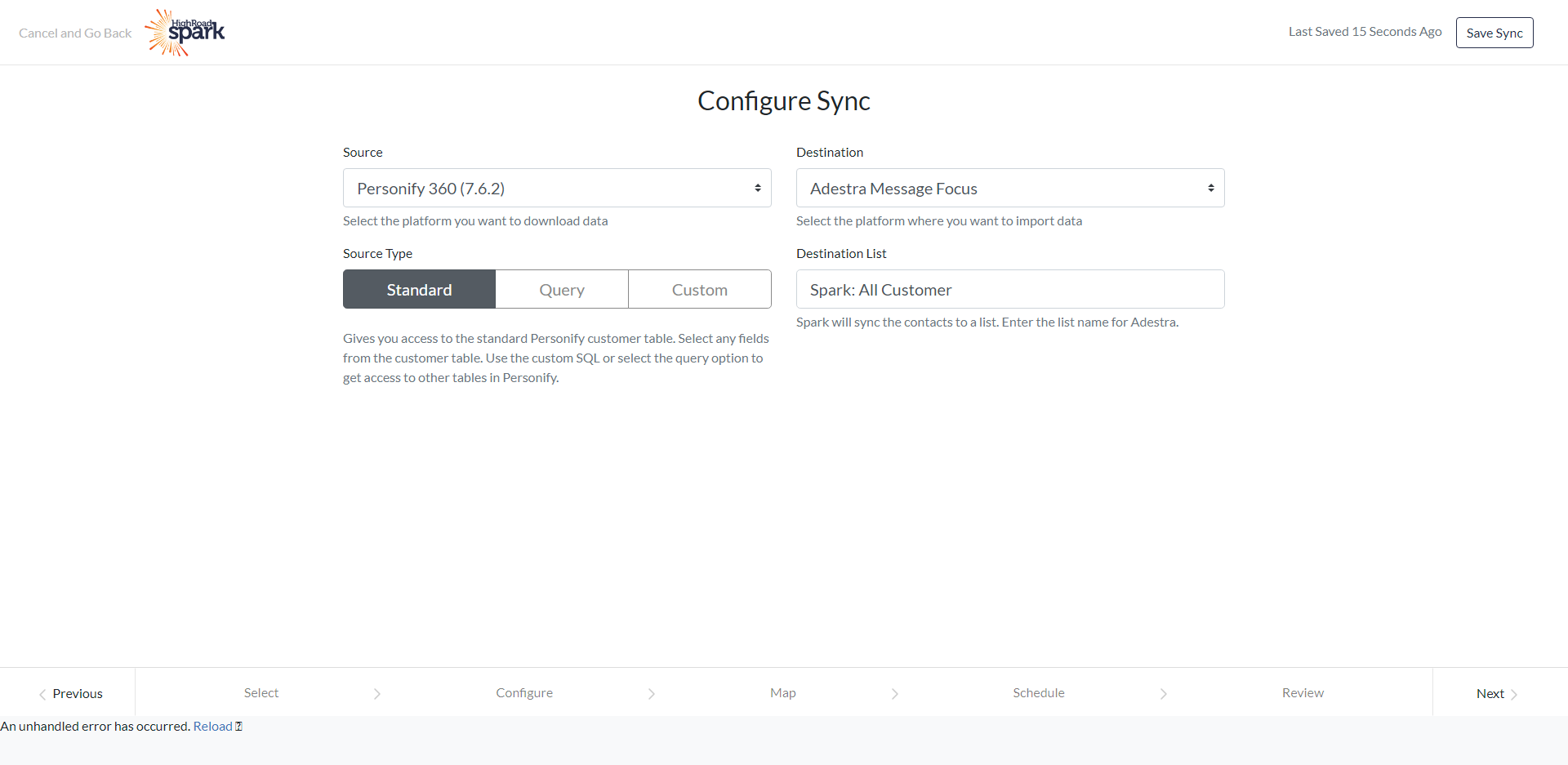
Integrations are monodirectional, so data can only ever travel from source to destination. This is good to know, as you can rest assured that Spark won’t change anything on the source database.
If you need data to travel the opposite way, simply create a new sync with the source and destination reversed.
APIs only allow certain types of queries. Some interfaces will only allow basic read/write operations. Others will allow you to run stored procedures, which are complex queries stored in the application database.
In Spark, there are three types of query available:
- Standard: This option runs a default query, like selecting all data from a database table. You should stick to this option if you’re not sure which query to use.
- Query: This allows you to run a custom query or stored procedure on the source database.
- Custom SQL: If permitted by the source application, this option allows you to write and execute your own SQL queries.
If you’re comfortable with SQL and databases, you can use the Query or Custom SQL option. If not, the Standard option should be fine.
Mapping is the process of creating a schema that tells the integration platform how to match columns in the source database to columns in the target database.
An example of a map might look like this:
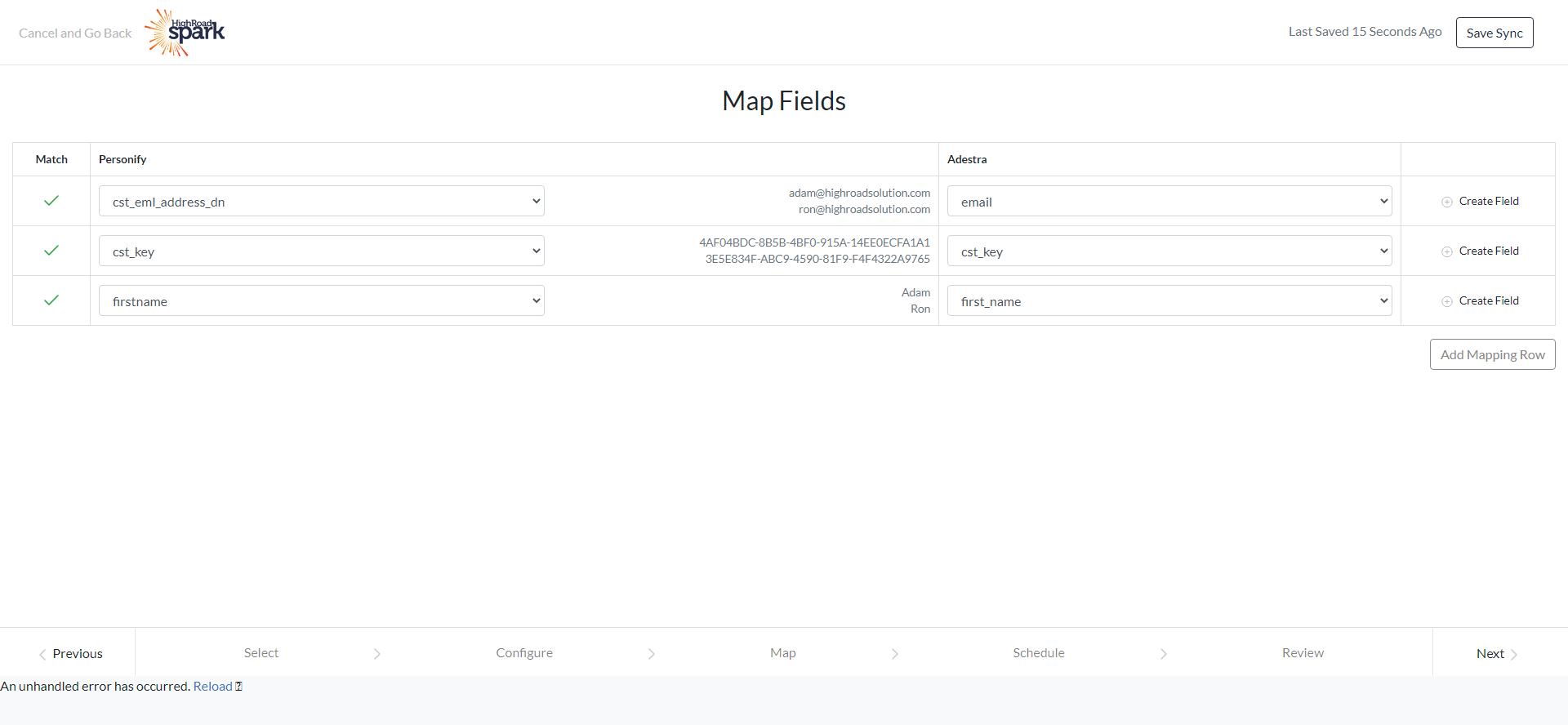
The data integration platform needs this map to understand the relationship between tables. For example, a computer could never figure out that a member’s join date and renewal date might be interchangeable.
In Spark, creating this map is easy, with zero coding experience required. Simply use the point-and-click interface to match fields together, and Spark will understand how to move data from one place to another.
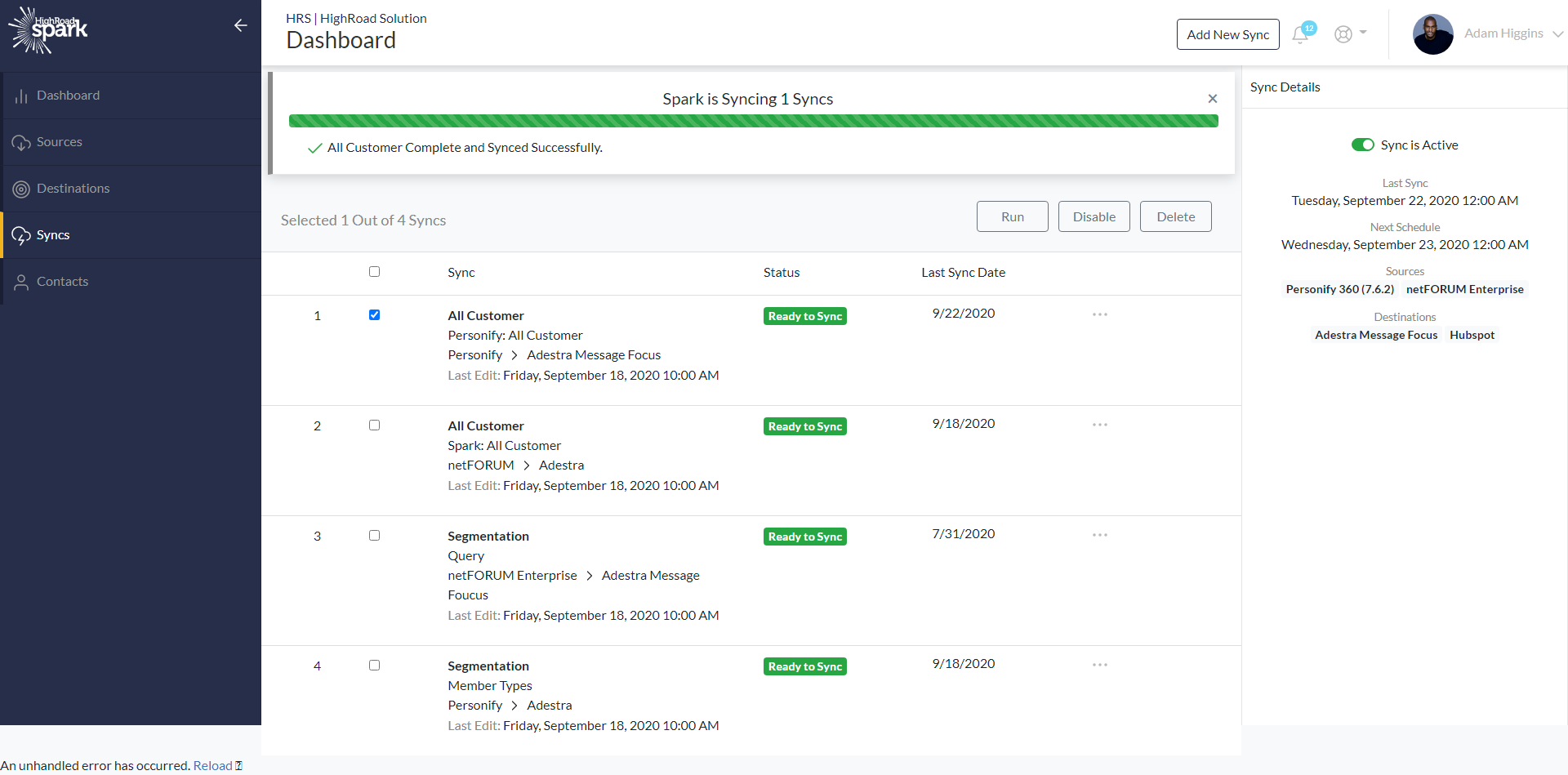
A regularly scheduled integration is known as a data pipeline. When you have an active pipeline, data flows from one system to the other without manual intervention. Data pipelines are essential for certain tasks, like updating the marketing automation platform with the latest contact details from the AMS.
The Spark Data Integration Library
A data integration platform is only as good as its integration library. You need a platform that offers one-click integration with your most important applications.
The Spark roadmap is all inclusive. Spark, unlike most commercial data integrations solutions, will work with all of the most popular AMS platforms, including:
- Aptify
- Fonteva
- iMIS
- Impexium
- NetForum
- Nimble AMS
- Personify
- YourMembership
Spark will also integrate with most mainstream and association market applications, including:
- Upland Adestra
- eShow
- OpenWater
- Cvent
- HubSpot
- SharpSpring
- Mailchimp
- Marketo
- Twilio
- Salesforce
Spark's integration library will start small and will then progressively expand, so watch this space for the latest developments.
Take control of your data integration
Nobody knows what’s going to happen next. This is scary, but it’s also exciting. It means there’s room to grow, to innovate, and to make your association indispensable for the next generation of members.
And there is a map to that future hiding somewhere in your data. You just need the right data integration platform to bring it all together, and you’ll start to get a picture of where to lead your members.
About Maneesha Manges
Maneesha Manges is a seasoned digital marketing professional with 20 years of experience working in multiple markets and global companies. Her prior experience includes consulting roles in digital marketing strategy, data analysis, field marketing and social media. Maneesha holds a Master of Business Administration degree in High-Tech Marketing from American University’s Kogod School of Business and a Bachelor of Arts degree in Economics from Concordia University in Montreal.






